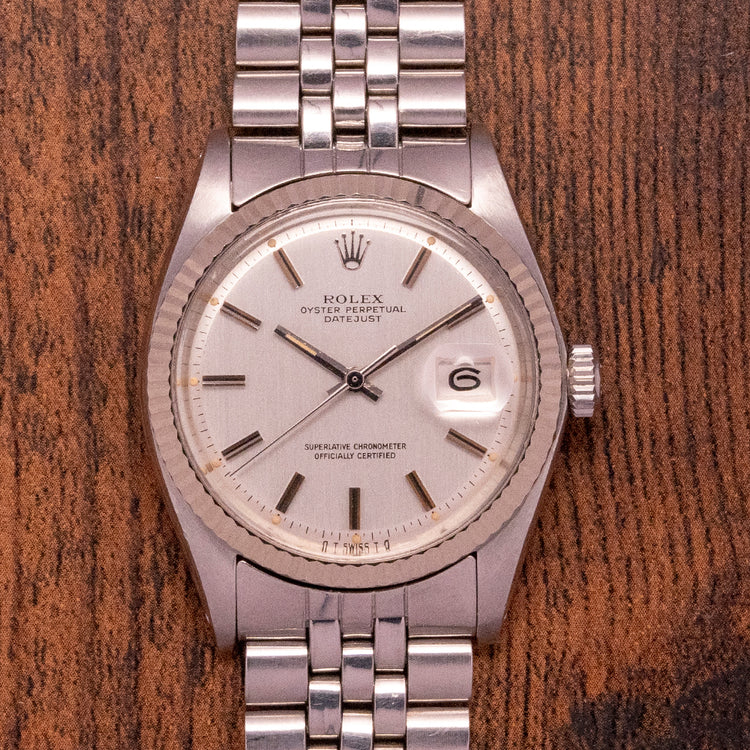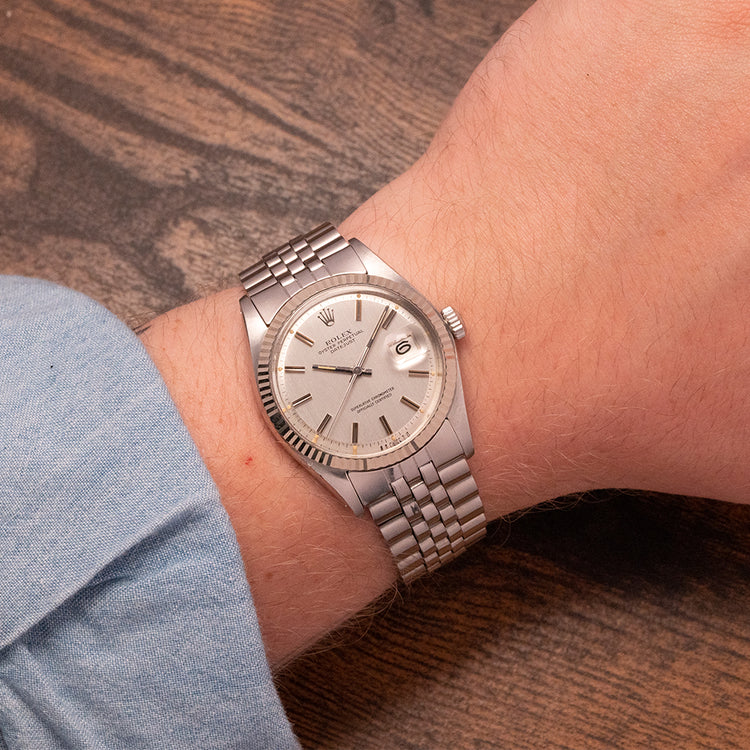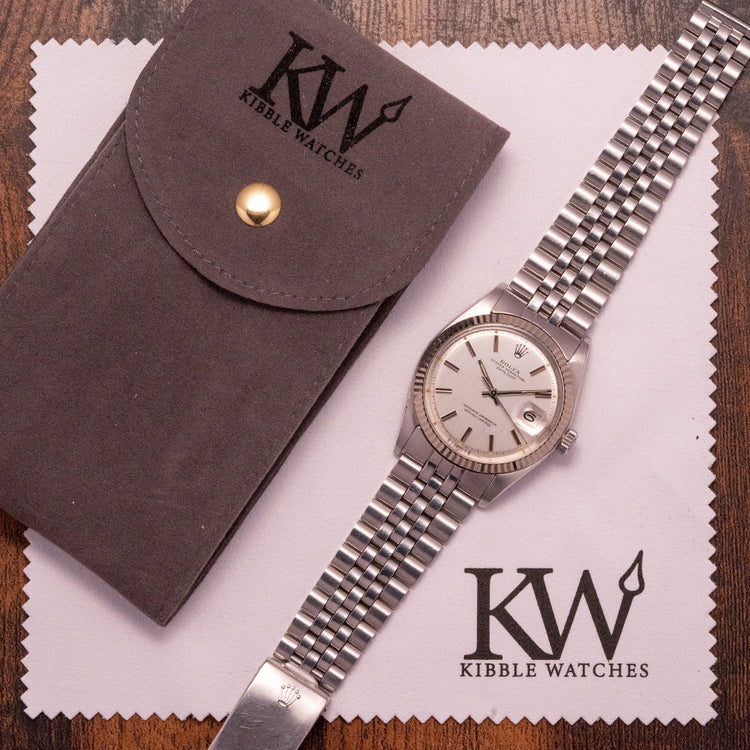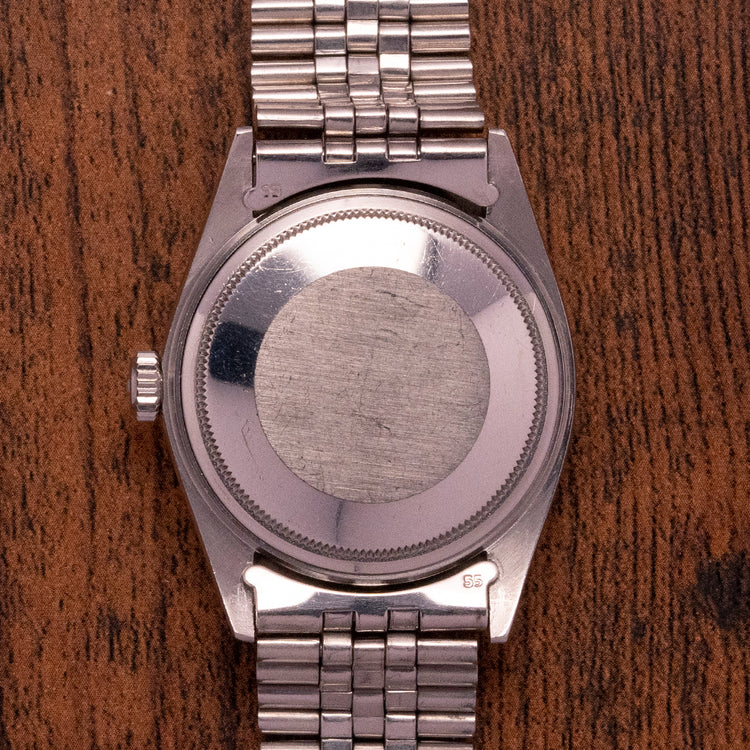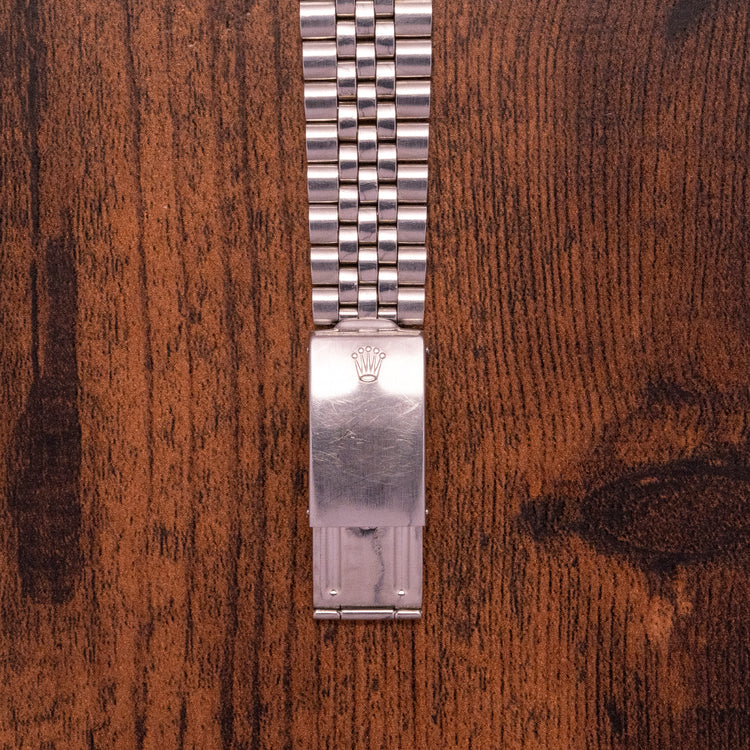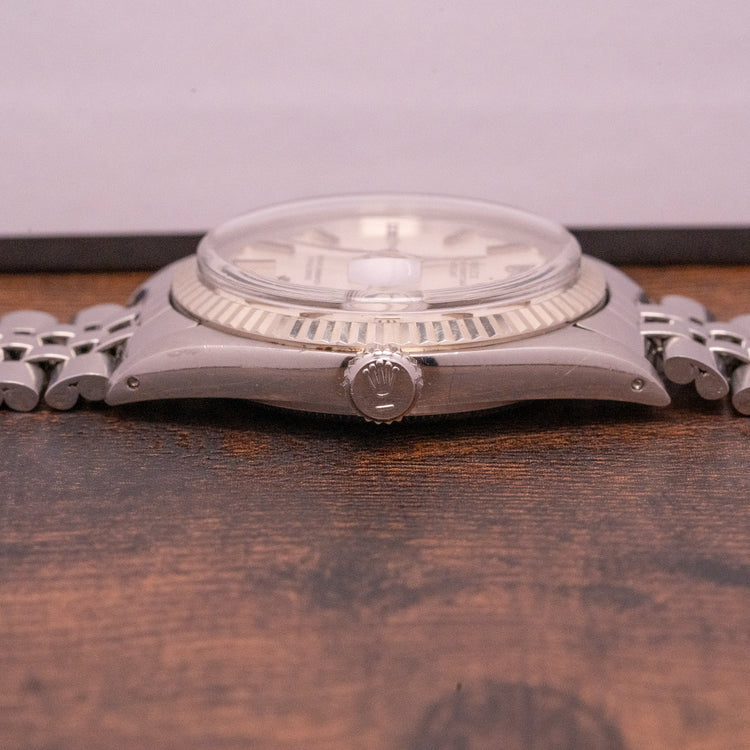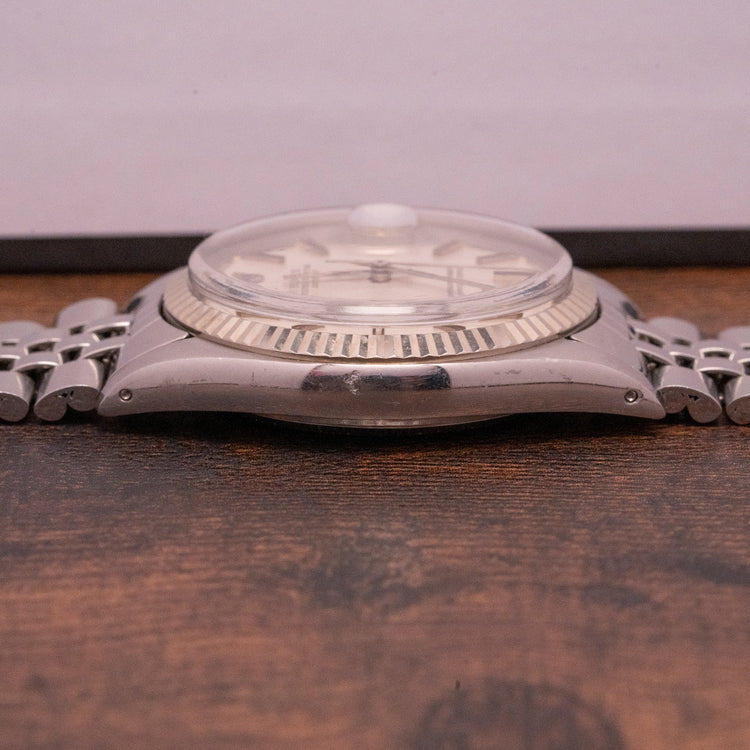More Information
Description
More
Less
The Watch
Here we have a 1973 Rolex Datejust 1601 Rare Sigma Dial with a 36mm stainless steel oyster case that gently curves towards the tapered drilled lugs for easy strap changing, a lug-to-lug length of 44mm and a thickness of 11.5mm ensuring a comfortable fit on your wrist. On the right side, a signed screw-down crown with deep knurling for extra grip. Polished and brushed surfaces transition with crisp edges, the 18ct white gold fluted bezel holds a domed plexiglass crystal above a rare vertical brushed silver Sigma dial marked “σ T SWISS T σ.” signifying the use of gold within the dial. During the 1970s, the Swiss watch industry trade association, L'Association pour la Promotion Industrielle de l'Or (APRIOR), wanted to highlight the value of Swiss watches that used any type of gold material when gold prices quadrupled between 1970 and 1974. A stepped-down outer minute track is precisely printed with Tritium lume pips at hourly intervals, applied 18ct white gold baton indexes have chamfered edges that catch the light magically as you rotate your wrist. At 3 o’clock a date window with a cyclops magnification on the crystal. Elegant 18ct white gold baton hands have chamfered edges and Tritium lume infill complemented by a finely tapered sweeping second hand. At 12 o’clock an applied Rolex crown, text is printed accurately at 12 “Rolex Oyster Perpetual DateJust” and 6 “Superlative Chronometer Officially Certified”. On the reverse, a coin-edged screw-down case back, inside an automatic Rolex Cal. 1570, 26 jewels, 19,800 beats per hour, this movement was first introduced in 1965 and was produced until 1974. The watch comes fitted on its original polished and brushed 20mm folded link Rolex Jubilee 6251 H bracelet with a Rolex folding clasp and 55 endlinks.
Points of Mention
This watch is sold as "Watch Only" and therefore comes with no original Rolex box or Rolex papers. The watch comes paired with a very nice 20mm folded link Rolex Jubilee 6251 H bracelet with a Rolex folding clasp and 55-endlinks. The watch is from Circa. 1973 and is in worn, vintage condition as you can see from the photos. Overall, however, the watch is very good for its age and the dial is completely original and never touched. The watch comes fresh from full service and a clean and the watch comes with our 12-Months NON-Waterproof Warranty.
For more photos see here - https://drive.google.com/drive/folders/1Vu-M4ZcLZeU_T338junkwJ2R_MZUCm42?usp=drive_link
4K YouTube video, skip to 6:00 - https://youtu.be/KKgfz8w73jo
Personal Note
The Rolex Datejust in 36mm is as classic as it gets for a Rolex in my opinion, especially paired on a jubilee with a fluted bezel. This 1601 features one of the very best Sigma dials I have ever seen, perfectly aged tritium throughout and paired on its original folded link Jubilee which is incredibly comfortable on the wrist. The great thing about a Datejust is it looks just as good on a strap as it does the bracelet in my opinion, so I wouldn't hesitate from picking up a few 20mm straps to go along with this watch.
Specification
Lugs : 20mm
Condition : Pre-Owned
Box & Papers : None
Case Material : Stainless Steel
The Brand
In 1905, German-born Hans Wilsdorf and his brother-in-law Alfred Davis set up a company in London that imported Swiss movements which are installed in British cases and sold to jewellers who put their names on the dials. Recognising the potential for their brand, Wilsdorf created the brand name Rolex in 1908. In 1910, a Rolex became the first wristwatch to carry the Swiss Certificate of Chronometric Precision, awarded by the Official Watch Rating Centre in Bienne, Switzerland. Demand for Rolex watches rose swiftly, and British taxes on the Swiss movements Rolex used prompted Wilsdorf to move the business to Geneva, Switzerland, in 1919. With production costs lowered, Wilsdorf quickly set out to solve the age-old problem of moisture and dust entering a watch case and damaging the movement. The Rolex watchmakers came up with a fully sealed watch case, which Wilsdorf named the Oyster, and released to an appreciative audience in 1926. In 1931, Rolex introduced the first automatic winding wristwatch, giving it the legendary name Oyster Perpetual. In 1945, they released Datejust. The Datejust was the first watch to have the date jump instantaneously at midnight. The 1950s saw a whole lot of releases such as the Air-King (1958), the Explorer (1953), the Submariner (1953), the GMT Master (1955), the Day-Date (1956), the electromagnetic field resistant Milgauss (1956), the Lady-Datejust (1957) and the first Deep Sea model (1960). Wilsdorf’s death in 1960, saw ownership of Rolex S.A. (a collection of sub-companies) passed to the Hans Wilsdorf Foundation which was founded by Wilsdorf in 1945, the mission of which is simply to sustain Rolex S.A. indefinitely.
Points of Mention
More
Less
Personal Note
More
Less
Specification
More
Less
Movement : Automatic Rolex Cal. 1570
Year : 1973
Case Size : 36mm
Case Thickness : 11.5 mm
Lug to Lug : 44mm
Lugs : 20mm
Condition : Pre-Owned
Box and Papers : None
Case Material : Stainless Steel
Warranty : 12-Months Non-waterproof Warranty
The wrist model's wrist size is 7inch
About Rolex
More
Less
Description
The Watch
Here we have a 1973 Rolex Datejust 1601 Rare Sigma Dial with a 36mm stainless steel oyster case that gently curves towards the tapered drilled lugs for easy strap changing, a lug-to-lug length of 44mm and a thickness of 11.5mm ensuring a comfortable fit on your wrist. On the right side, a signed screw-down crown with deep knurling for extra grip. Polished and brushed surfaces transition with crisp edges, the 18ct white gold fluted bezel holds a domed plexiglass crystal above a rare vertical brushed silver Sigma dial marked “σ T SWISS T σ.” signifying the use of gold within the dial. During the 1970s, the Swiss watch industry trade association, L'Association pour la Promotion Industrielle de l'Or (APRIOR), wanted to highlight the value of Swiss watches that used any type of gold material when gold prices quadrupled between 1970 and 1974. A stepped-down outer minute track is precisely printed with Tritium lume pips at hourly intervals, applied 18ct white gold baton indexes have chamfered edges that catch the light magically as you rotate your wrist. At 3 o’clock a date window with a cyclops magnification on the crystal. Elegant 18ct white gold baton hands have chamfered edges and Tritium lume infill complemented by a finely tapered sweeping second hand. At 12 o’clock an applied Rolex crown, text is printed accurately at 12 “Rolex Oyster Perpetual DateJust” and 6 “Superlative Chronometer Officially Certified”. On the reverse, a coin-edged screw-down case back, inside an automatic Rolex Cal. 1570, 26 jewels, 19,800 beats per hour, this movement was first introduced in 1965 and was produced until 1974. The watch comes fitted on its original polished and brushed 20mm folded link Rolex Jubilee 6251 H bracelet with a Rolex folding clasp and 55 endlinks.
Points of Mention
This watch is sold as "Watch Only" and therefore comes with no original Rolex box or Rolex papers. The watch comes paired with a very nice 20mm folded link Rolex Jubilee 6251 H bracelet with a Rolex folding clasp and 55-endlinks. The watch is from Circa. 1973 and is in worn, vintage condition as you can see from the photos. Overall, however, the watch is very good for its age and the dial is completely original and never touched. The watch comes fresh from full service and a clean and the watch comes with our 12-Months NON-Waterproof Warranty.
For more photos see here - https://drive.google.com/drive/folders/1Vu-M4ZcLZeU_T338junkwJ2R_MZUCm42?usp=drive_link
4K YouTube video, skip to 6:00 - https://youtu.be/KKgfz8w73jo
Personal Note
The Rolex Datejust in 36mm is as classic as it gets for a Rolex in my opinion, especially paired on a jubilee with a fluted bezel. This 1601 features one of the very best Sigma dials I have ever seen, perfectly aged tritium throughout and paired on its original folded link Jubilee which is incredibly comfortable on the wrist. The great thing about a Datejust is it looks just as good on a strap as it does the bracelet in my opinion, so I wouldn't hesitate from picking up a few 20mm straps to go along with this watch.
Specification
Lugs : 20mm
Condition : Pre-Owned
Box & Papers : None
Case Material : Stainless Steel
The Brand
In 1905, German-born Hans Wilsdorf and his brother-in-law Alfred Davis set up a company in London that imported Swiss movements which are installed in British cases and sold to jewellers who put their names on the dials. Recognising the potential for their brand, Wilsdorf created the brand name Rolex in 1908. In 1910, a Rolex became the first wristwatch to carry the Swiss Certificate of Chronometric Precision, awarded by the Official Watch Rating Centre in Bienne, Switzerland. Demand for Rolex watches rose swiftly, and British taxes on the Swiss movements Rolex used prompted Wilsdorf to move the business to Geneva, Switzerland, in 1919. With production costs lowered, Wilsdorf quickly set out to solve the age-old problem of moisture and dust entering a watch case and damaging the movement. The Rolex watchmakers came up with a fully sealed watch case, which Wilsdorf named the Oyster, and released to an appreciative audience in 1926. In 1931, Rolex introduced the first automatic winding wristwatch, giving it the legendary name Oyster Perpetual. In 1945, they released Datejust. The Datejust was the first watch to have the date jump instantaneously at midnight. The 1950s saw a whole lot of releases such as the Air-King (1958), the Explorer (1953), the Submariner (1953), the GMT Master (1955), the Day-Date (1956), the electromagnetic field resistant Milgauss (1956), the Lady-Datejust (1957) and the first Deep Sea model (1960). Wilsdorf’s death in 1960, saw ownership of Rolex S.A. (a collection of sub-companies) passed to the Hans Wilsdorf Foundation which was founded by Wilsdorf in 1945, the mission of which is simply to sustain Rolex S.A. indefinitely.
Points of Mention
Personal Note
Specification
The Brand
Enquire or Book an Appointment
Would you like to discover further details about this watch, or perhaps arrange an appointment to view and try it on? Complete this form and a member of our team will get back to you shortly.
You May Also Like




















